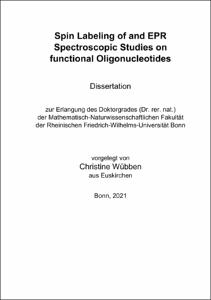Wübben, Christine: Spin Labeling of and EPR Spectroscopic Studies on functional Oligonucleotides. - Bonn, 2021. - Dissertation, Rheinische Friedrich-Wilhelms-Universität Bonn.
Online-Ausgabe in bonndoc: https://nbn-resolving.org/urn:nbn:de:hbz:5-62158
Online-Ausgabe in bonndoc: https://nbn-resolving.org/urn:nbn:de:hbz:5-62158
@phdthesis{handle:20.500.11811/9074,
urn: https://nbn-resolving.org/urn:nbn:de:hbz:5-62158,
author = {{Christine Wübben}},
title = {Spin Labeling of and EPR Spectroscopic Studies on functional Oligonucleotides},
school = {Rheinische Friedrich-Wilhelms-Universität Bonn},
year = 2021,
month = may,
note = {Within the last three decades, the central dogma of molecular biology has been extended in the sense that RNA is not only the molecule from which the genetic information is translated into proteins but is involved in many functions in cells. In order to gain an understanding of the function of the various RNAs on a molecular level, methods are required for studying their structures, since structure and function are inextricably interwoven. One of these methods is electron paramagnetic resonance (EPR) spectroscopy, which is employed here as the main tool because it has no size restriction and the RNA can be studied in solution. The work reported in this thesis had three major aims: (1) To establish a “click”-chemistry based site-directed spin labeling strategy for RNA with a new gem-diethyl nitroxide spin label and to characterize its EPR properties. The idea being that such a gem-diethyl nitroxide label would be suited for in cell measurements on RNA. (2) To use this labeling strategy in combination with Q-band Pulsed Electron-Electron Double Resonance (PELDOR or DEER) spectroscopy to experimentally test the proposed switching mechanism of the Guanidine-II riboswitch. (3) To quantify the number and affinity of Mn2+ ion binding sites in the 10-23 DNAzyme using continuous wave (cw) X-band EPR spectroscopy.
The labeling strategy was successfully implemented and EPR measurements revealed that this spin label on RNA has a surprisingly long relaxation time TM. Additionally, the PELDOR measurements on the truncated hairpins P1 and P2 of the Guanidine-II riboswitch were successful, proving that P1 and P2 do indeed form the proposed kissing hairpin P1 | P2. However, for the full-length riboswitch mainly intermolecular interactions were resolved making the identification of the anticipated intrastrand P1 | P2 interaction impossible. Finally, a reproducible protocol for the quantification of Mn2+ ion binding sites was established in the lab and was successfully applied to different forms of the 10-23 DNAzyme, supporting the structural/catalytic importance of these ions for this DNAzyme. Thus, the presented work contributes to a deeper understanding of oligonucleotide structure and function.},
url = {https://hdl.handle.net/20.500.11811/9074}
}
urn: https://nbn-resolving.org/urn:nbn:de:hbz:5-62158,
author = {{Christine Wübben}},
title = {Spin Labeling of and EPR Spectroscopic Studies on functional Oligonucleotides},
school = {Rheinische Friedrich-Wilhelms-Universität Bonn},
year = 2021,
month = may,
note = {Within the last three decades, the central dogma of molecular biology has been extended in the sense that RNA is not only the molecule from which the genetic information is translated into proteins but is involved in many functions in cells. In order to gain an understanding of the function of the various RNAs on a molecular level, methods are required for studying their structures, since structure and function are inextricably interwoven. One of these methods is electron paramagnetic resonance (EPR) spectroscopy, which is employed here as the main tool because it has no size restriction and the RNA can be studied in solution. The work reported in this thesis had three major aims: (1) To establish a “click”-chemistry based site-directed spin labeling strategy for RNA with a new gem-diethyl nitroxide spin label and to characterize its EPR properties. The idea being that such a gem-diethyl nitroxide label would be suited for in cell measurements on RNA. (2) To use this labeling strategy in combination with Q-band Pulsed Electron-Electron Double Resonance (PELDOR or DEER) spectroscopy to experimentally test the proposed switching mechanism of the Guanidine-II riboswitch. (3) To quantify the number and affinity of Mn2+ ion binding sites in the 10-23 DNAzyme using continuous wave (cw) X-band EPR spectroscopy.
The labeling strategy was successfully implemented and EPR measurements revealed that this spin label on RNA has a surprisingly long relaxation time TM. Additionally, the PELDOR measurements on the truncated hairpins P1 and P2 of the Guanidine-II riboswitch were successful, proving that P1 and P2 do indeed form the proposed kissing hairpin P1 | P2. However, for the full-length riboswitch mainly intermolecular interactions were resolved making the identification of the anticipated intrastrand P1 | P2 interaction impossible. Finally, a reproducible protocol for the quantification of Mn2+ ion binding sites was established in the lab and was successfully applied to different forms of the 10-23 DNAzyme, supporting the structural/catalytic importance of these ions for this DNAzyme. Thus, the presented work contributes to a deeper understanding of oligonucleotide structure and function.},
url = {https://hdl.handle.net/20.500.11811/9074}
}






